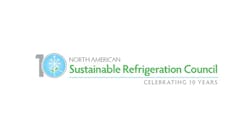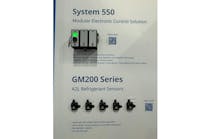Taking Control: Leading the Global Debate on the Phase-down of HFC Refrigerants
Today, as businesses, consumers and government increase focus on energy and environmental issues, OEMs and contractors in our industry can remain competitive not just by adapting to constant change, but by influencing and shaping that change. And when it comes to refrigerant changes, the question becomes: do we want to lead or risk losing control?
The phase-down of hydrofluorocarbon (HFC) refrigerants is a given, considering that common HFCs have global warming potentials (GWPs) between 1400 and 4000 times that of carbon dioxide. We just don’t know how or how fast the phase-down will happen. Environmental advocates and regulatory agencies around the world are focused on this. Some seek rapid phase-downs or even immediate bans of HFCs. What remains to be seen is when and how rapid that phase-down will occur, and what will emerge as the next generation of refrigerants – hydrocarbons (HCs), hydrofluoroolefins (HFOs), carbon dioxide (CO2), something entirely different, or a combination of these.
The Montreal Protocol is the global vehicle established in 1987 to eliminate the use of gasses with ozone depletion potential (ODP). Through this international agreement, the phase-out of chlorofluorocarbons (CFCs) and ongoing phase-out of HCFCs has successfully reduced emissions of ODP gasses. Atmospheric chlorine concentrations are now trending downward and are expected to return to pre-1980 levels by the year 2050.
The Montreal Protocol has knowledgeable staff in place around the globe that understands refrigerants and the complexity of modern air conditioning and refrigeration systems. As a result, it is widely recognized as the most successful multilateral environmental agreement.
It’s not surprising, then, that 108 countries, led by the United States, Canada and Mexico, support the Montreal Protocol as the vehicle-of-choice to phase down HFCs on a GWP weighted basis. All of the principal developed countries of the world are included in this list, along with many others.
Supporting a planned, orderly phase down of HFCs makes sense. Environmentally, it’s the right thing to do. Most importantly, the phase-down on a GWP weighted basis provides the certainty and flexibility that industry needs to continue to provide products that are critical to society.
By being proactive and shaping policy discussions, we can take charge of our destiny and eliminate the potentially negative impact of regulations imposed by those without a stake in our industry.
But from a business perspective, it’s just as important that our entire industry, including OEMs and contractors, be actively engaged in, supporting and even leading the movement that will transition us in an orderly manner to alternatives with lower GWP. By being proactive and shaping policy discussions, we can take charge of our destiny and eliminate the potentially negative impact of regulations imposed by those without a stake in our industry. We risk that HFCs could be lumped into the so-called ‘big basket of gases’ that refers to waste byproducts such as smokestack emissions and tailpipe exhausts.
Likely alternatives to HFCs do exist. CO2, for example, has a very low GWP and is ideal in certain systems. In the United States and Europe especially, leading supermarkets are beginning to utilize CO2 refrigerant systems. Naturally occurring propane and iso-butane also offer low GWPs but are flammable. To date, their use has been limited to self-contained systems with very small charges and isolated arcing components that could ignite the gasses. There are now many millions of refrigerators and freezers safely operating around the world with propane and iso-butane charges.
Developing countries are currently evaluating R-32 as an alternative to R-410A to replace R-22. Recently, a petition was submitted for U.S. Environmental Protection Agency SNAP (Significant New Alternatives Policy) approval of R-32 – a sign that alternatives to R-410A are beginning to move forward in the United States. While R-32 is an HFC, its GWP of 675 is one-third that of R-410A, providing a substantial GWP reduction for air-conditioning applications, as well as chillers, heat pumps and medium temperature refrigeration systems. It also enables a 20 to 40% system charge reduction compared to R-410A. However, it is slightly flammable, so equipment manufacturers must compensate for flammability in their designs. ASHRAE Standard 34-2010, which classifies refrigerants, has recently added a new “A2L” rating for mildly flammable refrigerants such as R-32 that have very weak or slow flame propagation properties. The option to use R-32 is an example of the importance of an orderly phase-down of HFCs on a GWP weighted basis. Such a regulatory regime allows industry to choose the best refrigerant to meet the phase-down.
New synthetics and blends, like HFOs, offer yet another alternative to HFCs. R-1234yf is designed to replace R-134a in automobile air-conditioning and similar systems. The refrigerant’s thermophysical and chemical properties require only minimal changes to systems designed for R-134a, and, like R-32, R-1234yf is mildly flammable and rated A2L. Blends of HFO-1234yf with existing HFCs are likely to provide lower GWP alternatives for other applications.
Although each of these alternative refrigerants may be thermodynamically viable, they should not be suddenly and broadly applied without careful consideration of design changes to existing systems. Adequate time is necessary to research, develop and test systems to ensure a safe transition that does not compromise energy efficiency, reliability, safety or other important characteristics. It is also important to note that the application plan for new refrigerants should include serviceability, carefully considering and anticipating contractors’ processes for reclamation and end-of-life disposal.
Adequate time is necessary to research, develop and test systems to ensure a safe transition that does not compromise energy efficiency, reliability, safety or other important characteristics.
Movements are underway in many countries to restrict the use of HFCs. As mentioned earlier, many countries already support the Montreal Protocol as the vehicle to enact a phase-down. Although a 2010 proposal submitted by the North American countries was defeated, 108 countries signed a declaration that encouraged all countries to promote policies and measures aimed at selecting low-GWP alternatives to HCFCs and other ozone-depleting substances, and declared their intent to pursue further action under the Montreal Protocol aimed at transitioning the world to environmentally-sound alternatives to HCFCs and CFCs.
However, developing countries like India, China and Brazil opposed the proposal, citing concerns about the economic development constraints such an agreement could impose. In an effort to collaborate with India, the U.S. State Department and the U.S. EPA helped to establish the Indo-U.S. Technical Task Force on HFCs as an outgrowth of the 16th Conference of the Parties (COP16), which was held in Cancun, Mexico in December 2010 to continue negotiations on efforts to address climate change. As members of this task force, industry representatives, representatives of environmental groups, scientists and government officials from India and the United States actively evaluated strategies that would make the phase-down of HFCs under the Montreal Protocol, or similar vehicle, a viable and appealing proposal for the Indian government and industry community. While India has still not supported the proposed amendment to phase down HFCs through the Montreal Protocol, there is now a broader, common understanding of the issues, obstacles and possible solutions. So we have taken a few steps forward.
Meanwhile, China is working on alternative refrigerants, such as R-290 (propane) and R-32. China has now submitted its HCFC Phaseout Management Plan (HPMP) with calls for use of these refrigerants to replace HCFC-22. Nevertheless, China continues to oppose the global phase-down of HFCs now supported by 108 countries. Other countries are enacting their own regulations regarding refrigerants. The European Union is now re-evaluating its F-Gas Directive which controls and limits use of HFCs. All these actions could lead to a complex global patchwork of regulations. A well-coordinated global action would be a better solution – one that would prevent such a patchwork from forming and would minimize the trade problems associated with patchwork legislation. And as a global industry, it is in our best interest to help lead the charge toward such a solution, using as our guide the success of the Montreal Protocol with regards to the transition from CFCs and HCFCs to HFCs.
Follow Contracting Business.com @ContractingBiz
The reasons to assume a leadership role are many. As an industry, we possess first-hand experience and knowledge of refrigerants and their applications. We understand the complexities surrounding the refrigerant issue. We’re also immersed in the search for alternatives to HFCs and are best able to evaluate their impact on existing systems, applications and operating efficiencies. And, we’ve demonstrated success, with energy efficiency levels in the air-conditioning industry that are double those of a few decades ago, even as we have replaced ozone-depleting refrigerants. Just as importantly, our industry understands the value of a measured approach to any transition – one that allows time and flexibility to adapt existing systems to operate with a new alternative – and the potential implications of a transition on the industries that we serve. By leading rather than following, we are better positioned to minimize the impact of abrupt transitions and avoid legislation that could be both cumbersome and unrealistic in its expectations and its processes.
The time to act is now. Even though some countries are resisting proposals already submitted, they face financial considerations that make negotiations not only possible, but necessary to their economic future. The Montreal Protocol represents the best body to ensure progress, with global respect and the governance structure in place and the power to enforce an agreement. Our job is to ensure the agreement addresses the needs and concerns of our industry by claiming a seat at the table and leveraging our understanding of HVACR technology to shape the conversation – before someone else shapes it for us.
Robert Wilkins is vice president, public affairs, Danfoss.









